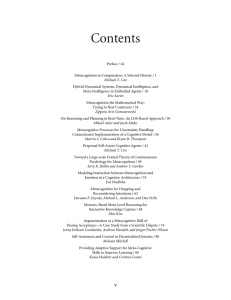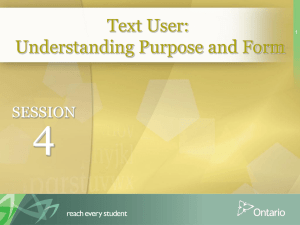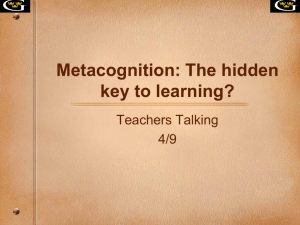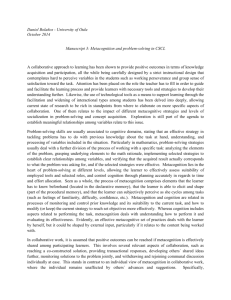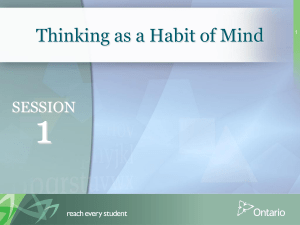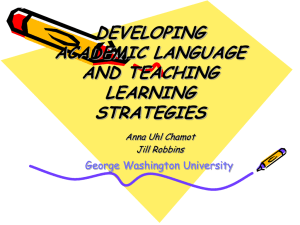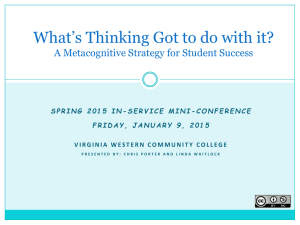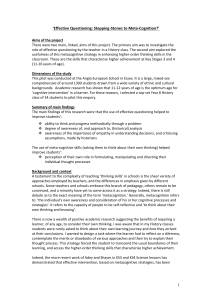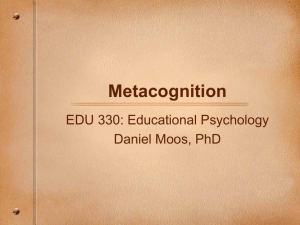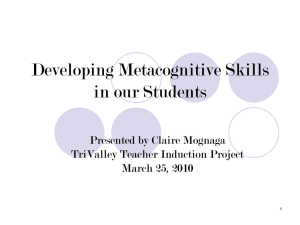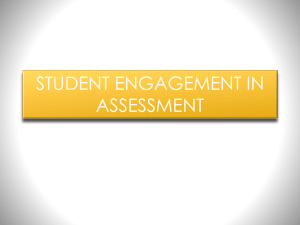Thinking about Thinking
advertisement
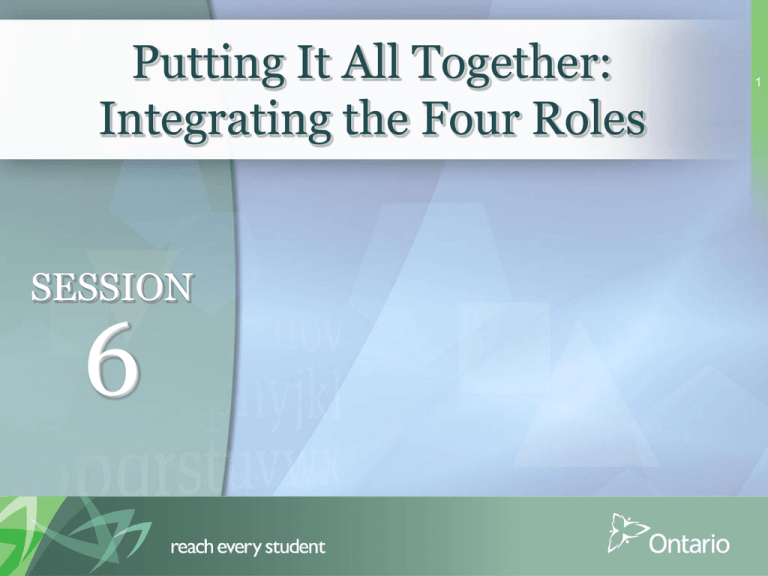
Putting It All Together: Integrating the Four Roles SESSION 6 1 Overview A learning resource for educators with six sessions: 1. Thinking as a Habit of Mind 2. Meaning Maker: Interacting with Text 3. Code User: Breaking the Code 4. Text User: Understanding Purpose and Form 5. Text Analyzer: Critically Thinking about Text 6. Putting It All Together: Integrating the Four Roles Thinking about Thinking: Setting the Stage for Independent Reading 2 Key Messages • Early primary students are capable of thinking about their own thinking. • The four roles of the literate learner model supports higher-order thinking in K–2 classrooms. • The Guides to Effective Literacy Instruction, Grades 4 to 6 support all teachers in planning effective literacy instruction. • Higher-order thinking is not about a series of events or lessons, but rather about developing a habit of mind. Thinking about Thinking: Setting the Stage for Independent Reading 3 Learning Goals for Session 6 This session is intended to: • explore metacognition as it applies to the four roles of the literate learner • examine metacognitive strategies for making thinking processes visible • examine the independent application of thinking processes, including peer and self-assessment Thinking about Thinking: Setting the Stage for Independent Reading 4 Evolving View: Four Roles of the Literate Learner “Metacognition is the process of thinking about one’s own thought processes. Metacognitive skills include the ability to monitor one’s own learning. Acquiring and using metacognitive skills has emerged as a powerful approach for promoting a focus on thinking skills in literacy and across all disciplines.” Health and Physical Education, 2010, p.62 Adapted from page 9 of Literacy for Learning: The Report of the Expert Panel on Literacy in Grades 4 to 6 in Ontario (2004). Based on Freebody and Luke’s “Four Resources Model” (1990). The Expert Panel elaborated on the four resources model to suggest four roles of a developing junior learner. For discussion purposes only based on the work of the Collaborative Inquiry in Literacy 2008–09 and 2009–10. Thinking about Thinking: Setting the Stage for Independent Reading 5 Metacognition Examine the metacognitive expectations for each strand in the language curriculum. • What are the implications for Kindergarten teachers? • What is the relationship between metacognition and self-regulation? • What is the relationship between metacognition and moving to independence? Thinking about Thinking: Setting the Stage for Independent Reading 6 Effective Metacognitive Strategies • activating prior knowledge and connecting it with new information • intentionally selecting and applying thinking strategies • monitoring one’s own learning • assessing one’s own learning A Guide to Effective Literacy Instruction, Volume One, 2006, p. 61 Thinking about Thinking: Setting the Stage for Independent Reading 7 Students talk about thinking View a video on the web: Thinking about Ourselves as Readers (Grade 2) Thinking about Thinking: Setting the Stage for Independent Reading 8 Student Self-Assessment Read the “Introduction” and the section titled “Terminology of Assessment,” as well as the sidebars on pages 2 and 3. Discuss implications for classroom practice in teaching and assessing metacognition. Thinking about Thinking: Setting the Stage for Independent Reading List strategies you would use to help develop metacognition and involve students in the assessment of their own thinking. 9 Peer and Student Self Assessment What opportunities do I provide for students to practise peer and self-assessment strategies? Gradual Release of Responsibility Model Teacher Responsibility Student Responsibility Source: From "Productive Work Group: How to Engage Students, Build Teamwork, and Promote Understanding" (p. 7), by Nancy Frey, Douglas Fisher & Sandy Everlove, Alexandria, VA: ASCS, © 2009 by ASCD, Reprinted and adapted with permission. Learn more about ASCD at www.ascd.org . Thinking about Thinking: Setting the Stage for Independent Reading 10 Inquiry Habit of Mind • Where can I situate opportunities for metacognition as I integrate the four roles of the literate learner? • What opportunities am I giving students to build metacognitive skills and assess their own learning? • Where changes in my practice might result from the ideas presented today Thinking about Thinking: Setting the Stage for Independent Reading 11 Inquiry Habit of Mind What is the impact of __________________ (teacher practice) on ________________________ (change in student learning)? Thinking about Thinking: Setting the Stage for Independent Reading 12 Acknowledgements We would like to thank the following staff members from Bond Lake Public School, York Region District School Board, for welcoming us into their school and classrooms to share the thinking and learning of their students. Kim Smith – principal Joanne Babalis – Kindergarten teacher Julie Ham – Kindergarten, Early Childhood Educator Andria Greaves – Grade 1 teacher Wendy Janes – Grade 1 teacher Sarah Tulley – Grade 2 teacher Aynsley Maxwell-Turanski – Grade 1/2 teacher Chris Reeves – teacher librarian Marguerite Gervan – special education resource teacher A special thank you to the many students from Bond Lake Public School whose thinking about their thinking supports the learning of educators across Ontario throughout this resource. Thinking about Thinking: Setting the Stage for Independent Reading 13 Hand-outs and Reference Documents All resource and curriculum documents used in Thinking about Thinking sessions are available online in PDF. Please visit the following web page to download them: http://resources.curriculum.org/LNS/thinking/session6.html Thinking about Thinking: Setting the Stage for Independent Reading 14
